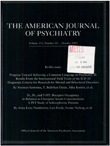Multiple personality disorder in The Netherlands: a clinical investigation of 71 patients
Abstract
OBJECTIVE: The aim of this study was to describe the phenomenology of multiple personality disorder as presented in a group of Dutch patients. METHOD: Seventy-one patients with multiple personality disorder were interviewed with the Dutch version of the Structured Clinical Interview for DSM-III-R Dissociative Disorders (SCID-D); following the SCID-D, the Structured Trauma Interview was administered. Before the interview, patients completed the Dissociative Experiences Scale. RESULTS: The presenting characteristics of the patients showed a striking resemblance to those in several large North American series. Patients had spent an average of 8.2 years in the mental health system prior to correct diagnosis. Patients presented with many different symptoms and frequently received other psychiatric or neurological diagnoses. A history of childhood physical and/or sexual abuse was reported by 94.4% of the subjects, and 80.6% met criteria for posttraumatic stress disorder. CONCLUSIONS: Patients with multiple personality disorder have a stable set of core symptoms throughout North America as well as in Europe. To improve the detection of patients at high risk for multiple personality disorder, standardized instruments for inquiry about dissociative pathology should be used as part of routine diagnostic assessment.
Access content
To read the fulltext, please use one of the options below to sign in or purchase access.- Personal login
- Institutional Login
- Sign in via OpenAthens
- Register for access
-
Please login/register if you wish to pair your device and check access availability.
Not a subscriber?
PsychiatryOnline subscription options offer access to the DSM-5 library, books, journals, CME, and patient resources. This all-in-one virtual library provides psychiatrists and mental health professionals with key resources for diagnosis, treatment, research, and professional development.
Need more help? PsychiatryOnline Customer Service may be reached by emailing [email protected] or by calling 800-368-5777 (in the U.S.) or 703-907-7322 (outside the U.S.).



